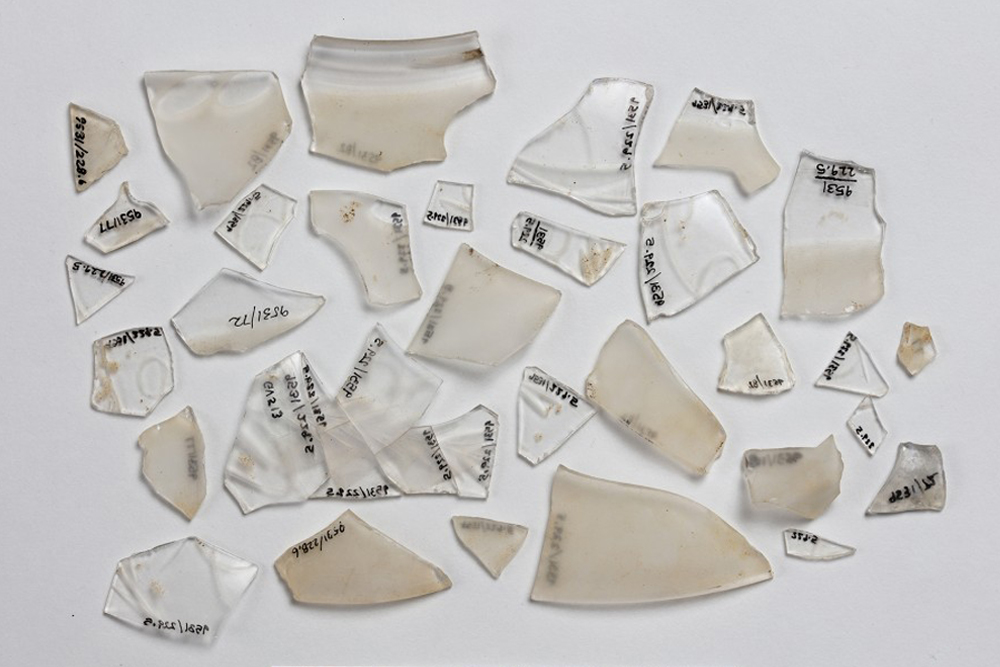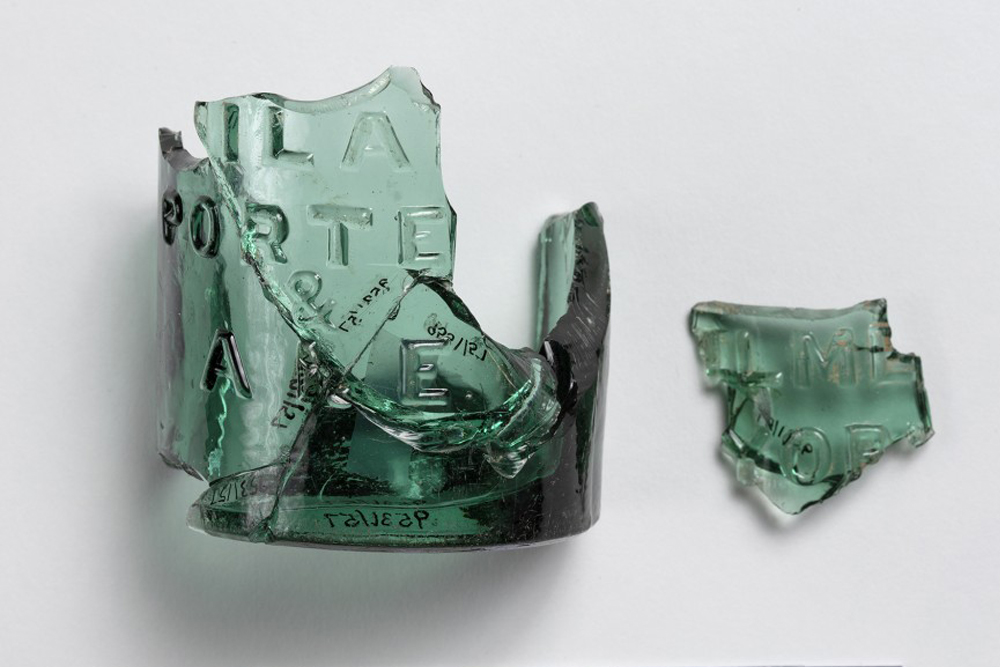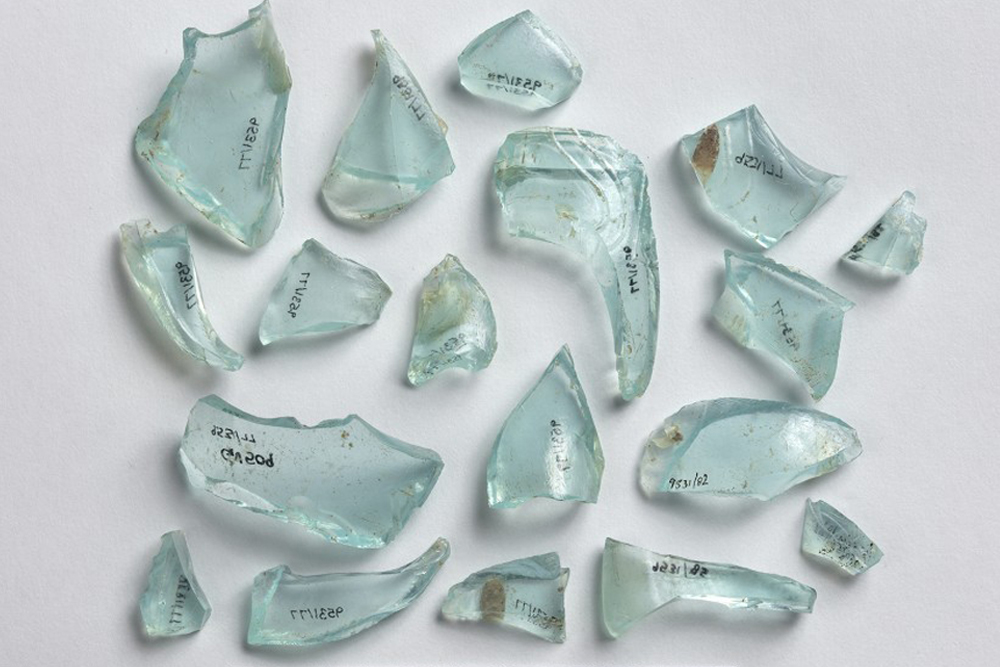Porter and ale bottle
The embossing on the remnants of this bottle reads “ILA,” “PORTE,” and “ALE,” and it was found between the sites of the Webster and Phillips homes. While the first two words, or fragments thereof, do not give much information about the object outright, the last one tells its explicit purpose. At one point, this bottle stored porter and ale.

Figure 1: Base of the bottle fragment. (Photo courtesy of the NYC Archaeological Repository).
Bottle Production
The primary function of a bottle is to store liquids. Dark green glass was durable enough to be used in place of other storage containers, like stoneware. Over time, glass bottles became less expensive than stoneware containers (Jones 1986, 11). They were also traditional in Europe, where the storage of alcoholic beverages in glass began around 1650 (Jones 1986, 19). Bottles were manufactured in glasshouses and blown individually, until the use of molds became more common around 1820. In factories, three sizes were typically used for alcoholic beverages. The one used for beer was called the “English Ale/Beer Gallon” (Jones 1986, 73), typically shorter and wider than wine bottles. This bottle was likely made using either a dip mold or a snap mold, both of which made the process of forming bottles more efficient. Snap molds can be identified by the seams along their sides, which is hard to decipher by looking at this fragmented bottle. Dip molds were more commonly used for ale and wine bottles until the 1870s (Lindsey 2020). Embossing was done with a plate mold or slug plate, and was only done on bottles created with molds (Stelle 2001).

Figure 2: The raised underside of the bottle. (Photo courtesy of the NYC Archaeological Repository).
Alcohol Trade and Production
Alcohol was a normal and integral part of colonial culture in the United States (Rorabaugh 1991, 17), though the types that people consumed were influenced by shifting demographics. After the Revolutionary War, rum, an English import via the Caribbean, was unavailable. Americans began drinking whiskey brought by Irish immigrants. Other elements, like the availability of ingredients, affected how and what people drank. In the 1790s, Midwest farmers began making their own alcohol from the excess of corn crops being grown (Rorabaugh 1991, 17). Although alcohol consumption was an important facet of daily life (partially attributed to a lack of clean water), religious groups, like the Quakers and some Methodists, began to oppose its pervasiveness.

Figure 3: This painting (Clark, William, “Exterior of a Distillery, on Weatherell’s Estate, Antigua,” 1823) depicts a rum distillery in Antigua. A majority of the laborers featured are Black.
Changing Perceptions of Alcohol
The Temperance Movement
The Temperance movement was a social and political effort to end the sale of alcohol on both state and national levels. The removal of alcohol was intended to curb issues arising in urban areas (California State University Oviatt Library 2013), like poverty and the destruction of family life, which the white middle class associated with drinking. The American Society of Temperance, formed by clergymen in 1826, spread anti-alcohol messaging through Protestant churches, and by 1835, 1.5 million Americans pledged to stop consuming hard liquor. The New York Temperance Society had about 88,000 members, while the total population of the city was 290,000 (Moore and Gerstein 1981). The shifting public perception of liquor consumption (see Figures 3-4) by these middle class social groups made abstinence a middle- and upper-class domestic value (Chrzan 2013, 73). They viewed themselves as morally superior to the urban working class, and, by shifting their set of values, further distanced themselves from the poor.
Differing Views
Although the Temperance movement was successful in decreasing hard liquor consumption–whiskey and rum consumption dropped by half from 1820-1850–the movement did not curb the consumption of other spirits, like wine and beer, as significantly. Alcohol had been associated with individual freedom in the colonial period and was already part of daily life. There was also an influx of immigrants from Ireland and Germany in the 1840s and 50s, for whom whiskey and beer were culturally important. Beer consumption increased from 1850-1870, as large breweries were established (Moore and Gerstein 1981) and lager was introduced by German immigrants.
Drinking and Recreation
It is difficult to know the exact opinions of drinking held by the Webster and Phillips households. But the combination of recreational objects–a pipe, two bottles and a lamp–suggest that they spent some of their time indoors (or outdoors) at night. Perhaps they indulged in drink as a way to unwind. Although drinking hard liquor in public locations, like bars and taverns, was becoming stigmatized (Chrzan 2013, 65), having a lighter drink at home was more acceptable and likely part of many individuals’ rituals of relaxation or informal social gatherings. Recreation is an integral part of life and human experience. Although the ways in which people chose to relax or spend time away from work looked very different among different social classes, the need to unwind was mutual.

Figure 5: “Kitchen Ball at White Sulphur Springs, Virginia,” Christian Friedrich Mayr, 1838.
Works Cited
Arthur, Timothy. 1848. Temperance Tales. Philadelphia: W. A. Leary & Co. http://utc.iath.virginia.edu/sentimnt/galltsaaf.html
Chrzan, Janet. 2013. Alcohol : Social Drinking in Cultural Context. New York, NY: Routledge.
Jones, Olive. 1986. Cylindrical English Wine and Beer Bottles, 1735-1850. Studies in Archaeology, Architecture, and History. Ottawa, Canada: National Historic Parks and Sites Branch, Environment Canada-Parks.
Lindsey, Bill. 2020. “Historic Glass Bottle Identification & Information Website.” Society for Historical Archaeology and Bureau of Land Management. http://www.sha.org/bottle/index.htm
Moore M.H., Gerstein D.R. 1981. “Alcohol and Public Policy: Beyond the Shadow of Prohibition.” National Research Council (US) Panel on Alternative Policies Affecting the Prevention of Alcohol Abuse and Alcoholism. https://www.ncbi.nlm.nih.gov/books/NBK216414/.
New York City Archaeological Repository: The Nan A. Rothschild Research Center. 2020. “Seneca Village.” NYC Landmarks Preservation Commission, New York, NY. http://archaeology.cityofnewyork.us/collection/map/seneca-village.
Rorabaugh, W. J. 1991. “Alcohol in America.” OAH Magazine of History 6, no. 2: 17-19.
Stelle, Lenville J. 2001. “An Archaeological Guide to Historic Artifacts of the Upper Sangamon Basin.” Center For Social Research, Parkland College. http://virtual.parkland.edu/lstelle1/len/archguide/documents/arcguide.htm.
Szary, Michael. n.d. “Rum in Colonial America.” The Economy of Goods (blog). https://projects.cah.ucf.edu/economyofgoods/index.php/2016/12/11/rum-in-colonial-america/.
“The Temperance Movement.” 2013. California State University Oviatt Library. https://library.csun.edu/SCA/Peek-in-the-Stacks/Temperance.






